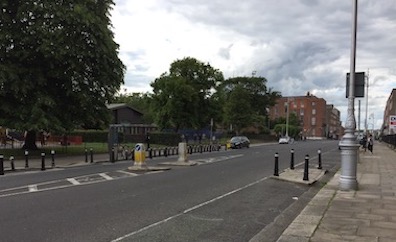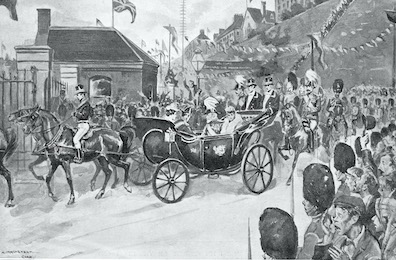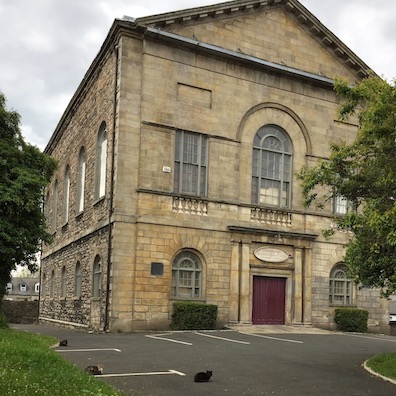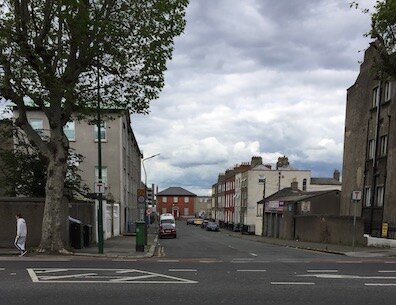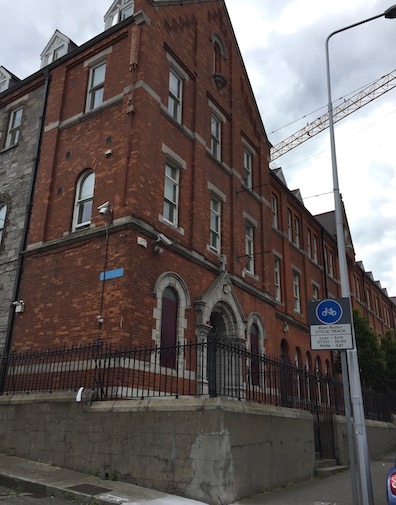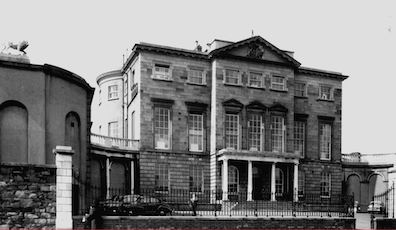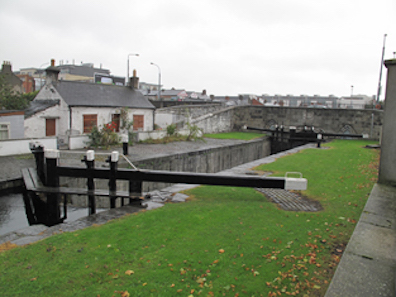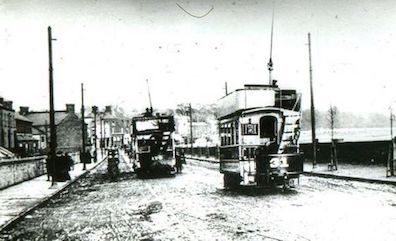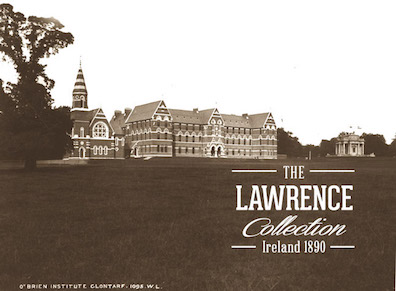Walk to Artane
Walk to Artane
In Brief
Initial space-time. The first section of Wandering
Rocks, like the last, depicts a long journey, this one
on the northeastern edge of the city. At 2:55 PM Father John Conmee looks at his watch
and reflects that it is a good time to "walk to Artane," a
suburb beyond Clontarf and Killester where the O'Brien
Institute for Destitute Children housed, fed, and educated
orphaned boys. It is a trip of well over two miles, but the
priest rides a tram for some of the distance. According to Clive
Hart's painstaking calculations he should arrive at
about 3:39. Section 1 shows Conmee passing numerous clearly
identified urban features, many of which held strong personal
associations for Joyce. In a single interpolation it jumps to
another section sited in a different part of town. This
sentence, and another one that sounds like an interpolation
but is not, lead by obscure byways to section 19.
Read More
In 1898 Father Conmee became Superior of the community of priests and nuns at St. Francis Xavier's church. Just as the real Conmee acted on behalf of John Stanislaus Joyce to see that James and Stanislaus would be educated without charge at Belvedere College, sparing them from the ignominy of a Christian Brothers education, the fictional one acts in this chapter to secure a Christian Brothers education for Paddy Dignam's fatherless son Patsy. He hopes to accomplish this goal by speaking to "Brother Swan," the Director of the O'Brien Institute.
After descending the steps of the presbytery,
Father Conmee walks to the western corner of "Mountjoy
Square," a small park one block southeast of his church, and
then proceeds to skirt half of the park's perimeter. Walking
by "the treeshade of sunnywinking leaves" on the northwest
edge of the park, he crosses paths with "the wife of Mr David
Sheehy M.P." and then, at "the corner of Mountjoy Square"
(its northernmost point), he meets "three little schoolboys"
who are receiving a Jesuit education at Belvedere. He gives
one of them a letter to post in "the red pillarbox at the
corner of Fitzgibbon street," just across the street.
(If the mailbox still existed—it does not—it would now be
painted green.) In addition to the boys' association with
Belvedere, Joyce would have felt personal attachment to
Fitzgibbon Street. His family moved there from Blackrock in
1892, to number 14, a house that is now numbered 34.
Turning right at the corner rather than proceeding up
Fitzgibbon Street to the North Circular Road, Father Conmee
walks along the park railings on "Mountjoy square east,"
the street that fronts the northeastern edge of the park.
There, he greets "Mrs M'Guinness" who is walking on
"the farther footpath" on the other side of the street. In James
Joyce's Dublin Ian Gunn and Clive Hart note that she is
"probably walking either to or from her house and place of
business at 38-39 Upper Gardiner Street" (45). With the
ludicrous worship of aristocracy that he indulges throughout
the section, the priest ennobles her: "A fine carriage she
had. Like Mary, queen of Scots, something. And to think that
she was a pawnbroker! Well, now! Such a... what should he
say?... such a queenly mien." The incongruity of seeing
noble bearing in a pawnbroker is amplified by a reader's
momentary impression that perhaps the woman drives about town
in a grand vehicle like those seen in the viceregal cavalcade
at the end of the episode. Mrs. M'Guiness will pop back into
the narrative in section 4, when Maggy Dedalus tells her
sisters she took some of her brother's books to the pawnshop
and "They wouldn't give anything on them." Boody Dedalus
provides a counterpoint to the priest's admiration for the
pawnbroker's fine carriage: "— Bad cess to her big face!
she cried."
After reaching the eastern corner of the park, diametrically
opposite the one where he began, Conmee turns left on "Great
Charles street," heading northeast. Glancing at "the
shutup free church on his left," he sees notice of a
sermon to be delivered by the "incumbent" minister, which
Gifford glosses as "the minister in charge." The church,
Gifford notes, is shut up "in that it is not open for prayer,
as a Catholic church would be." Designed by architect Edward
Robbins, it was built by Methodists in 1800 and originally
called the Wesley Chapel. Some two decades later it was
transferred to the Church of Ireland and functioned for many
years as a "free church," which, according to the site
Archiseek.com, is "one where no pew debts are paid," relying
entirely on "voluntary subscription." The Free Church closed
in 1988, and the building now houses the shutup Pavee Point Traveller and Roma Centre.
Soon after passing this building, Father Conmee comes to the
end of Great Charles Street and reaches the major thoroughfare
regarded in 1904 as a northern boundary of Dublin, turning
right and walking "along the North Circular road. It
was a wonder that there was not a tramline in such an
important thoroughfare. Surely, there ought to be." Possibly
the priest's legs are suggesting to him that he has chosen too
long a journey to undertake entirely on foot. The North
Circular Road passes by North "Richmond street," the
cul de sac in which the protagonist of "Araby," the third
story of Dubliners, lives. The Joyce family lived
there too, and in 1893 James attended the Christian Brothers
school that Daniel O'Connell
founded on the street in 1828. Joyce's fictions never directly
acknowledge those facts, but here the narrative shows Father
Conmee greeting some "Christian brother boys" crossing over
the North Circular Road from North Richmond. Angling slightly
to the right, the North Circular Road becomes Portland Row,
and Conmee continues on it, perhaps hoping to catch one of the
trams that ran up Amiens Street from the train
station, just as various bus lines do today.
"Father Conmee smelt incense on his right hand as he walked.
Saint Joseph's church, Portland row. For aged and virtuous
females. Father Conmee raised his hat to the
Blessed Sacrament. Virtuous: but occasionally they were also
badtempered." Two Catholic institutions are located here, a
church and an Asylum for Aged and Virtuous Single Women. In
1836, devoted layman James Murphy founded an "Asylum for aged
single females of unblemished character," and in 1891 the
Archbishop opened a large new building for its use. At the
time depicted in the novel, an order of nuns called Poor
Servants of the Mother of God would have tended to the needs
of the elderly single women in the hostel. For more on Murphy
and the history of the institution, see M. R., "The Founder of
St. Joseph's Asylum, Dublin," The Irish Monthly 25
(1897): 543-47. Today the nursing home is gone and the
building that once housed it has become part of the Dublin
Institute of Technology.
A little farther down Portland Row, "Near Aldborough house
Father Conmee thought of that spendthrift nobleman. And now
it was an office or something." Edward Stafford, 2nd
Earl of Aldborough, an Irish peer who according to Gifford
"already had town houses in Dublin and London and country
houses in England and Ireland," had this house built in the
1790s "in what was then the country.... This monumental
extravagance was compounded by his wife's refusal to live in
the house because she did not like its location." Extravagant
waste though it was, the house is architecturally notable as
the last great Irish work of Palladian architecture of the
18th century, and the last great townhouse built in Dublin.
After Leinster House, it was the second-biggest Georgian
private home in the metropolitan area.
Stafford died in 1801 and the house sat uninhabited for the
next twelve years. A former Cistercian monk, Gregor von
Feinaigle (source of the word "finagle," which indicates
something of his methods), bought it in 1813 and converted it
into a school, which did not last past 1830. At some point in
the 1840s it became a military barracks. In the second half of
the 19th century it was acquired by the Post Office for use by
the Stores Department and it continued in this role until
1999, losing its gardens to Corporation
housing projects in the 1940s. For most of the 21st century it
has been disused, vandalized, and decaying, with significant
water damage from thieves stealing the lead that sealed the
roof. During the Celtic Tiger years, a series of developers
bought the building but failed to realize their plans to
renovate it. Plans are now underway to reclaim its destined
function as "an office or something," adding modern glassed-in
wings on either side.
Father Conmee now turns left and heads up the "North
Strand road," which continues Amiens Street to the
northeast. There, the residential tenor of his walk turns
commercial. On the left he passes "Mr William Gallagher,"
a grocer and coal merchant at number 4, "Grogan's the
Tobacconist" at number 16, "Daniel Bergin's
publichouse" at number 17, and "Youkstetter's, the
porkbutcher's" at number 21, as well as "H. J.
O'Neill's funeral establishment" at number 164
(virtually across the street from the other four
establishments but 150 numbers higher), exchanging salutations
all along the way. Every one of these businesses has
disappeared. In The Ulysses Guide Robert Nicholson
notes that "Bergin's and Youkstetter's vanished suddenly one
night when a German bomber crew mistook Ireland for Britain
(the human victims are commemorated in a memorial garden
nearby). The buildings have since been replaced by Corporation
housing, as was H. J. O'Neill's funeral establishment, across
the road at No. 164" (76).
Approaching the Royal Canal
on the North Strand Road, Father Conmee sees a turfbarge "Moored under the trees
of Charleville Mall," a short quay-like street running
along the edge of the canal on the northwestern side of the
small "Newcomen Bridge." The road passes over the canal
via this bridge, and on it Father Conmee "stepped on to an
outward bound tram," because "he disliked to traverse on
foot the dingy way past Mud Island." Mud Island, known
earlier as Friend's Field or French Field, was the name from
the late 18th century onward for the muddy expanse in the area
where the River Tolka flows into Dublin Bay—the "North Strand"
of the road's name. In The Bloomsday Trams (2009),
David Foley observes that in these "sloblands" the river
"poured factory and household waste into Dublin Bay. The place
was well known for it's [sic] powerful stench at low
tide" (13). By 1904 some projects had already begun to reclaim
these tide flats for urban use, and in the 1920s a large new
swath of dry land became the attractively landscaped Fairview
Park that fronts the bay today. The Joyce family lived in
several different houses in the Fairview area, hard by a muddy
beach rather than precious parkland.
Father Conmee continues riding the tram up the North Strand
Road and over the "Annesley Bridge" where it crosses
the River Tolka. He gets off at "the Howth road stop,"
which today would be very close to the Clontarf stop on the
DART line. Here, Nicholson notes, he would be "within view of
15 Marino Crescent, home of Bram
Stoker" (77). From this point on the southwestern edge
of Clontarf, there is not only a Howth Road leading
east-northeast to the Howth peninsula but also a Malahide Road
leading north-northeast to the village of Malahide. Father
Conmee begins walking up "The Malahide road," thinking
about the "road and name," and
the port, and the famous castle and its Talbot lords and
ladies. Walking along this road, he encounters a
"flushed young man" and a young woman with a twig caught in
her light skirt. They turn out much later to have been
Stephen's friend Lynch and his girlfriend, engaged in
fornication in the bushes.
The section ends here, but presumably Father Conmee's legs
carry him the rest of the way up the Malahide Road past
Griffith Avenue to a small country lane that leads first to
the Marino Casino, a lovely 18th century folly designed by
Scottish architect William Chambers for the 1st Earl of
Charlemont, and then to the O'Brien Institute. Today the large
building houses the Dublin Fire Brigade Training Centre, while
the Marino Casino has become a popular tourist destination.
[2023] Section 10 contains one interpolation: "Mr Denis J
Maginni, professor of dancing &c, in silk hat, slate
frockcoat with silk facings, white kerchief tie, tight
lavender trousers, canary gloves and pointed patent boots,
walking with grave deportment most respectfully took the
curbstone as he passed lady Maxwell at the corner of
Dignam's court." This meeting at the corner of Dignam's
Court (now Parnell Place) and Great Britain Street (Parnell
Street) takes place quite a few blocks southwest from where
Father Conmee is walking, but it nevertheless reaches back to
insinuate connections with his story. The priest is on a
mission to help the Dignam family. Maginni is seen at Dignam's
court, in a well-off neighborhood they could not hope to live
in. The narrative implies some tension between their two
journeys.
There is also convergence in the divergence. As Clive Hart
observes, "Conmee, smiling, is eager to make himself
agreeable. Maginni is associated with the art of
self-advertisement" (Critical Essays, 203). Each man is
embarked on a parade of self-promotion, the one displaying
clerical rectitude and the other artistic flash. Another
interpolation in section 10 reports that "On O'Connell bridge
many persons observed the grave deportment and gay apparel of
Mr Denis J Maginni, professor of dancing &c." In section
19 the dancing master's walking course, which has now brought
him to Grafton Street, finds him "outpassed by a viceroy and
unobserved." By showing Maginni and the viceroy crossing on
independent and oblivious paths, Joyce shows Art operating
independently of both Church and State. The symmetrical
numerical patterning of Maginni's appearances (sections 1, 10,
and 19) suggests conscious overarching design.
Section 1 performs at least one more spatiotemporal trick. At
the Newcomen Bridge there is a quick shuffling of viewpoints:
On Newcomen bridge the very reverend John Conmee S.J. of saint Francis Xavier's church, upper Gardiner street, stepped on to an outward bound tram.
Off an inward bound tram stepped the reverend Nicholas Dudley C. C. of saint Agatha's church, north William street, on to Newcomen bridge.
At Newcomen bridge Father Conmee stepped into an outward bound tram for he disliked to traverse on foot the dingy way past Mud Island.
No interpolation is involved here: Conmee is boarding a tram
at the same instant that Dudley is getting off the same
vehicle. But the prose, bristling with parallelisms, flashes
from one man to another, and back to the first, in a kind of
quick-cut montage seen more often in films than in novels. The
narrative sleight of hand realistically approximates the mute
social dance that tram stops and bus stops produce: step off,
notice a fellow clergyman stepping on, no time to exchange
pleasantries, back to one's private thoughts. It manages to
suggest, in one tiny detail, the endlessly intersecting
journeys conducted on a weekday in a big city. Conmee's
starting point is Dudley's terminus: different business is
taking them to different destinations.
But this detail also insinuates one final twist: the
clergyman's name, Dudley, links him to the Earl of Dudley, the
viceroy whose carriage will take him on a southeasterly course
through Dublin (rather than southwesterly like his namesake,
or northeasterly like Conmee) in section 19. Ecclesiastical
and civil authorities, like the Symplegades in the
Bosporus, knock against each other once more in this
hugely overdetermined chapter.

Bartholomew's 1900 map of Dublin, with Father Conmee's route to the O'Brien Institute superimposed in blue arrows. Source: Pierce, James Joyce's Ireland.
